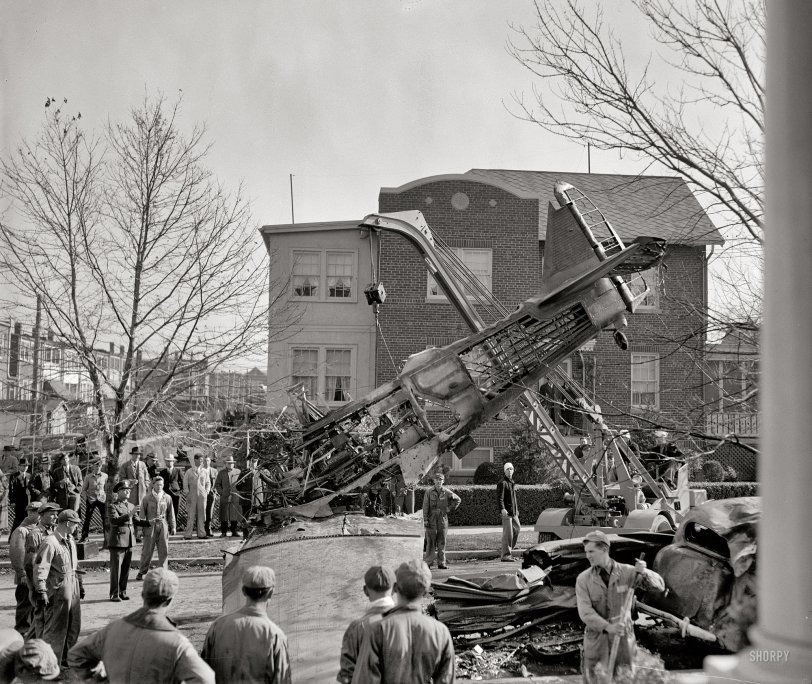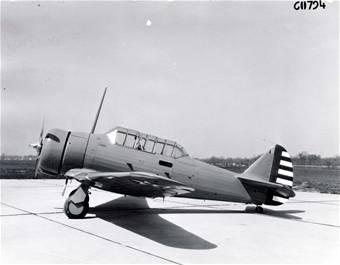


Framed or unframed, desk size to sofa size, printed by us in Arizona and Alabama since 2007. Explore now.
Shorpy is funded by you. Patreon contributors get an ad-free experience.
Learn more.

- Lofty addition
- In 1912
- Keenan Building
- Six years old
- Taken from the P.J. McArdle Roadway?
- It stood only 47 years
- Three track mind
- Incline to the right
- Reach for the sky, 1912 style
- No clean sweep
- Same Job Title, Same Face
- Sadly Lost
- Beautiful ...
- Where you get your kicks
- Aim High
- Pueblo Revival sisters
- Pueblo Neoclassicism
- Milk Man
- Regional dialect.
- Spielberg's inspiration
- Great Photo
- Loaf Story
- Do you still have the Rakes category?
- Could almost be a scene from the 1957 movie 'Hell Drivers'
- The Wages of Fear.
- Conspicuous by their absence
- Got Milk?
- All that aluminum
- No lefties
- Smoke 'em if you've got 'em
Print Emporium
Plane Crash: 1938

November 9, 1938. Washington, D.C. "Two U.S. Army fliers -- Lieut. Col. Leslie MacDill, General Staff Corps Officer, and Private Joseph G. Gloxner -- were burned to death today in the worst aerial tragedy in the history of the Capital when their plane crashed on a street in Anacostia, a short distance from Bolling Field. Three automobiles were wrecked in the crash. Col. MacDill was piloting the plane." Harris & Ewing Collection glass negative. View full size.
Correction!
OK, somewhat late to the thread, but the Washington Post article states:
"Col. MacDill was a graduate of Hanover College, University of Indiana, and the Army War College."
'Tis and 'twas "Indiana University," not "University of Indiana. Harrumph.
Spent 22 years in the USAF, never realized MacDill was named after a fellow Hoosier, tho.
Conductor
The Army man guiding the crane is not an officer. His cap device is that of an elisted man.
The 'Before' Picture
Not the exact plane, of course, but same model.

Military operation
The whole removal project was apparently carried out by the army. The three men to the right of the officer in charge are no doubt army men. One has staff sergeant stripes, one buck sergeant and can't tell about the other. The man on the viewer's right has coveralls over his uniform. The little billed fatigue hats are a sure sign. There is likely a navy man there too. The man in the white hat looks to be in a dungaree uniform with his white hat turned down. I'd guess that the navy furnished the crane from the Washington Navy Yard.
Harry Rosenthal
>> Louis Fiedler, mechanic, and Harry Rosenthal, manager of Mandell Chevrolet garage at Thirteenth street and Good Hope road, and Earl Hazel, of 1235 U street southeast, rushed to the plane with fire extinguishers.
Harry went on to open his own Chevrolet dealership some years later. Mandell Chevrolet was owned by Ben Ourisman, who had named the dealership after his son.
Conducting? Yes, in a manner of speaking.
I think you'll find that the military man is "conducting" the operation of lowering (or lifting) the aircraft carcass and that his orchestra is the crane driver.
A Man Cooked Alive!
Stanton Square's observations about lurid old reporting styles reminded me of the way that the accidental death of one of my great-grandmother's cousins was described by a reporter for the Virginia City (Nevada) Territorial Enterprise, on December 21, 1871, under the tasteful headline "A Man Cooked Alive!" Michael T. Comerford, the deceased, was a silver miner who accidentally hit his head on a beam while going for some ice to cool his tea during a dinner break deep in the mine, and fell into the boiling hot spring at the bottom of the drift he was in, and was scalded to death. The article took nearly ten column inches to describe the gruesome details of his condition when his fellow miners found him a few hours later. A mild example: there were claw marks in the mud where he had attempted to pull himself out, and his hands were described as looking like old, swollen yellow kid gloves. It was a few days before Christmas, and Comerford left a young wife and three small children. The article concluded with these staunch words: "To break the terrible news to the poor man's widow was a task the miners shrank from, but it had to be done."
Different details
Indeed, it is interesting how ordinary news accounts of decades ago leave in details related to death and injury. Suicides were routinely reported. Even traffic accident reports from the '30s, an era of journalistic interest to me, note that someone fractured a leg, say. Now, whether because of heightened sensitivity to privacy, or of hospitals' legal reluctance to offer details, or of newspapers' awareness that offended readers can become ex-readers, the results of violence don't get described as often as they used to.
(Of course, the reverse seems to be the case in sexual descriptions...)
A one, two, three, four...
The military guy with the cigarette hanging out of his mouth looks like Arte Johnson of "Laugh-In" fame. He seems to be conducting an orchestra in the middle of the street. Very surreal.
Heard Body Plop
A revealing insight into how journalistic sensibilities have changed (evolved?) regarding the lurid details of a gory story. ("the head was torn from the other," "a plop which suggested to him falling of a human body," "I couldn't clean up the brains splattered on my car.")
Washington Post, Nov 10, 1938Army Studies Cremation of 2 Fliers Here
Crash in Anacostia Fire Destroys Plane
Officer is Killed, Pilot Dies AlsoA special Army board last night was investigating the crash which killed and cremated two Army fliers when their pursuit plane went into a spin, narrowly missed two houses and smashed to earth in Anacostia, 2 miles from Bolling Field.
The dead were Col. Leslie MacDill, 49, of the War Department general staff, who lived at 3105 Cathedral avenue northwest, and Private Joseph G. Gloxner, of First Staff Squadron, of Reading, Pa. Both were instantly killed.
Maj. Charles P. Prime, chief investigator, said last night that eyewitnesses have given conflicting reports regarding engine trouble. Coroner A. Magruder MacDonald said he would postpone decision on holding an inquest into the deaths until he had received the Army report.
Trouble With Motor
The BC-1 pursuit plane piloted by Col. MacDill took off from Bolling Field at 9:36 a.m. Three minutes later it crashed on S street, a block away from the busy intersection of Good Hope road and Nichols avenue.
Accounts pieced together from numerous eyewitnesses indicate that something happened to the motor and Col. MacDill tried to get back to his field, and then with death staring him in the face aimed his plane for a narrow space between two houses in order to land on Thirteenth street, headed for an alley.
The plane cut down telephone and power wires, knocked down a pole, clipped off tree limbs and plunged into the earth between the curb and street in front of the home of Robert Thompson, 1807 Thirteenth street, southeast.
The plane immediately burst into flames, settled back on a parked car. Burning gasoline flowed down the street and destroyed three other parked cars.
One civilian came within 10 feet of being killed in the crash. That was Clarence W. Ohm, plumber of 1612 W street southeast. He had parked his car directly across the street from the crash, and was just getting from his car when the plane struck.
Flames Leap 50 Feet
Both bodies were burned beyond recognition by the flames which leaped as high as 50 feet. One of the bodies was thrown from the fuselage, while the head was torn from the other. Fireman fought half an hour with water and chemicals.
Louis Fiedler, mechanic, and Harry Rosenthal, manager of Mandell Chevrolet garage at Thirteenth street and Good Hope road, and Earl Hazel, of 1235 U street southeast, rushed to the plane with fire extinguishers. The heat drove them away. Fiedler's face was scorched.
The street at the time of the crash was deserted except for Ohm. Few people were attracted by sound of the plane until it exploded because Anacostia residents have become accustomed to low-flying planes.
Heard Body Plop
Ohm related that because of a broken gasket on the exhaust pipe of his automobile, he heard nothing until a plop which suggested to him falling of a human body. From his parked car he heard a scream and saw a body on the pavement before an explosion "like a 16-inch gun" shot up huge clouds of black smoke and flames.
Still shaking from his experience last night he said, "it was the most horrible thing I ever saw. I thought the world was coming to and end. I have felt so bad all day I couldn't clean up the brains splattered on my car."
Col. MacDill was a graduate of Hanover College, University of Indiana, and the Army War College. He leaves his wife, Mrs. Marilla Augusta MacDill, and two daughters, Katherine Rose, 14, and Rose, 11.
Col MacDill was first commissioned a second lieutenant, Coast Artillery Corps, in 1912. By time of the World War he had been promoted to captain of Air Corps. Overseas he organized the Aerial Gunnery School at St. Jean de Monts, France.
In 1920 he was graduated from Massachusetts Institute of Technology and held several commands until 1930 when he came to Washington in Plans Division, Office of Chief of Air Corps. After attending the Army and Naval War Colleges, he returned here in 1934.
The bodies of both men are being held at Walter Reed Hospital.
The crash scene today; remarkable how little the house has changed.
North American BC-1
Col. MacDill was flying a North American BC-1, used by the Army Air Corps from 1936 to 1940. The BC-1 evolved into the AT-6 Texan (or SNJ in Navy nomenclature, "Harvard" to the British). The AT-6 is often seen at air shows, as many of them were purchased as inexpensive surplus after the war.
MacDill Air Force Base near Tampa, Florida, is named for Col. MacDill.
























On Shorpy:
Today’s Top 5